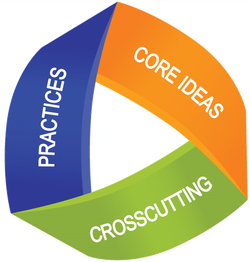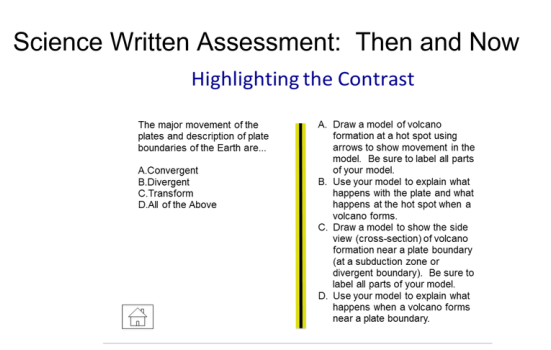Science Assessment - Diagnostic, Formative, and Summative

|
Because scientists achieve their own understanding by building theories and theory-based explanations with the aid of models and representations and by drawing on data and evidence, students should also develop some facility in constructing model- or evidence-based explanations. This is an essential step in building their own understanding of phenomena, in gaining greater appreciation of the explanatory power of the scientific theories that they are learning about in class, and in acquiring greater insight into how scientists operate.
~The Framework |
What will assessment look like?
Diagnostic? Formative? Summative?
What types of assessment will be used? When?
What will performance tasks look like?
What will performance tasks look like?
Assessment of units following the NGSS standards will need to be shifted from traditional pencil and paper tests that measure what a student remembers to instead authentic assessments that assess how students use the practices of science to understand crosscutting concepts and disciplinary core ideas.
Authentic assessments to see if students have met performance expectations must be three dimensional and could include:
-observing students carry out an investigation
-conferring with individual students
-conferencing in small groups
-having students make models to use to form an explanation or a prediction
-having students analyze data
-having students engage in evidence-based argument writing
-having students create a drawing to show relationships and form an explanation
-having students synthesize information from various sources
-....all or several of the above
Regardless of the methods used, more than one assessment is necessary and assessments will need to have interrelated, multiple components and be varied in their style.
Authentic assessments to see if students have met performance expectations must be three dimensional and could include:
-observing students carry out an investigation
-conferring with individual students
-conferencing in small groups
-having students make models to use to form an explanation or a prediction
-having students analyze data
-having students engage in evidence-based argument writing
-having students create a drawing to show relationships and form an explanation
-having students synthesize information from various sources
-....all or several of the above
Regardless of the methods used, more than one assessment is necessary and assessments will need to have interrelated, multiple components and be varied in their style.
PErformance Expectations
Standards expressed as performance expectations:
- combine practices, core ideas, and crosscutting concepts into a single statement of what is to be assessed
– require students to demonstrate knowledge-in-use
- performance expectations are not instructional strategies or objectives for a lesson
- intended to describe the end–goals of instruction
Christopher Harris - SRI International
- combine practices, core ideas, and crosscutting concepts into a single statement of what is to be assessed
– require students to demonstrate knowledge-in-use
- performance expectations are not instructional strategies or objectives for a lesson
- intended to describe the end–goals of instruction
Christopher Harris - SRI International
Evidence Statements
Evidence Statements provide the behaviors of students that should be observed by teachers. The are detailed descriptions of the performance expectations and describes what the 3-dimentional learning should look like.
High school
Middle grades
Elementary grades
High school
Middle grades
Elementary grades
next generation science assessment
Formative Assessments and Record Keeping
In order to formatively monitor student proficiency with specific skills, this assessment form example provides a method for recording how well students are doing. It is one component to creating a "photo album" as opposed to a "snapshot" of students' progress using both qualitative and quantitative measures in order to make informed instructional decisions.
Template
Template
Rubrics
Rubrics can be created based on the evidence statements. Benchmark rubrics can assess end-of-unit expectations. Formative assessment progress monitoring forms can also be created based on evidence statements.
*Rubric Example with Benchmark Assessment Rubric and Progress Monitoring
*Rubric Example with Benchmark Assessment Rubric and Progress Monitoring
So Then...what Will
Student Evidence
of LEarning Look Like?
Assessment Resources
Developing Assessments for NGSS - A resource with specific examples.
Next Generation Science Assessment - Task portal for grades 3-8.
Science Assessment Item Collaborative - Documents and prototypes designed to help states in assessing NGSS and great guidance for local districts as well.
Next Generation Science Assessment - Resources that includes a "Task Portal" that provides web-based and interactive knowledge-in-use formative assessments to drive instruction.
Assessment for Learning - Rationale, examples and steps for creating assessments from the California Science Framework.

